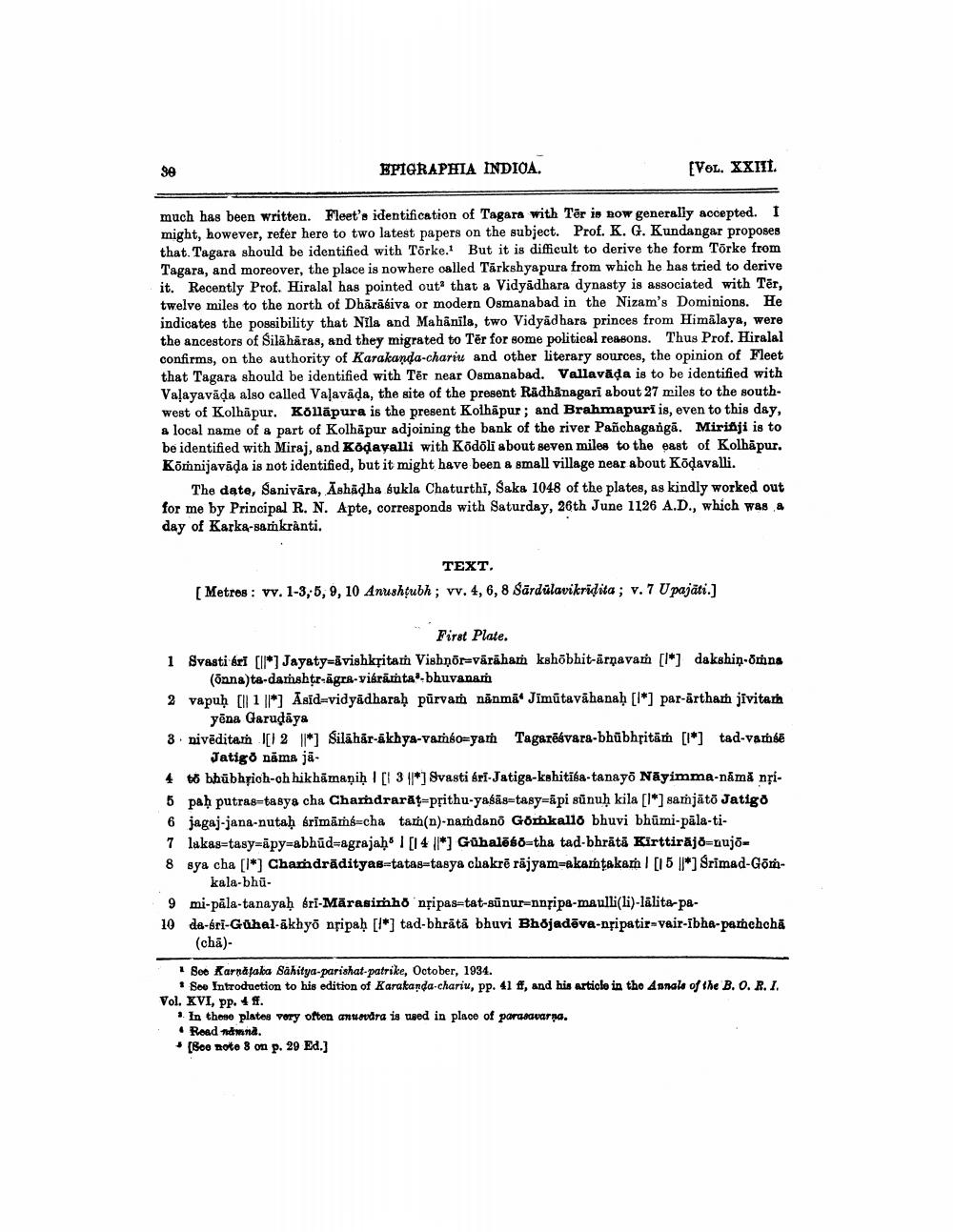________________
EPIGRAPHIA INDIOA.
[Vol. XXII.
much has been written. Fleet's identification of Tagara with Tēr is now generally accepted. I might, however, refer here to two latest papers on the subject. Prof. K. G. Kundangar proposes that. Tagara should be identified with Törke. But it is difficult to derive the form Tõrke from Tagara, and moreover, the place is nowhere called Tärkshyapura from which he has tried to derive it. Recently Prof. Hiralal has pointed out that a Vidyadhara dynasty is associated with Tēr, twelve miles to the north of Dhārāśiva or modern Osmanabad in the Nizam's Dominions. He indicates the possibility that Nila and Mahânila, two Vidyadhars princes from Himālaya, were the ancestors of Silāhāras, and they migrated to Tēr for some political reasons. Thus Prof. Hiralal confirms, on the authority of Karakanda-chariu and other literary sources, the opinion of Fleet that Tagars should be identified with Tēr near Osmanabad. Vallavāda is to be identified with Valayavāda also called Valavāda, the site of the present Radhanagari about 27 miles to the southwest of Kolhapur. Kollāpura is the present Kolhapur ; and Brahmapuri is, even to this day, a local name of a part of Kolhapur adjoining the bank of the river Pañchaganga. Mirifji is to be identified with Miraj, and Ködavalli with Kõdõli about seven miles to the east of Kolhapur. Komnijаvāda is not identified, but it might have been a small village near about Kõdavalli.
The date, Sanivära, Ashidha kukla Chaturthi, Saka 1048 of the plates, as kindly worked out for me by Principal R. N. Apte, corresponds with Saturday, 26th June 1126 A.D., which was a day of Karka-samkranti.
TEXT [Metres : vv. 1-3, 5, 9, 10 Anushçubh ; vv. 4, 6, 8 Sārdülavikridita ; v. 7 U pajāti.)
First Plate. 1 Svasti eri [] Jayaty=ivishkțitam Vishnor-väräham kshõbhit-ārņavam [1*] dakshin.Omns
(onna)ta-damshţr-Agra-vibranta-bhuvanam 2 vapuh [ 1 ||*) Asid=vidyādharah pūrvam nānmä* Jimītavāhana) [l*] par-ārtham jivitath
gēna Garudaya 3 nivēditar |[12 Il*] Silahár-akhya-vambo=yam Tagarēsvara-bhūbhritam [1*] tad-varse
Jatigo nama jā4 to bhübhpich-oh hikhāmaṇiḥ 1 [1 311*] Svasti éri-Jatiga-kahitība-tanayo Nāyimma-nāmi nși5 paḥ putras-tasya cha Chandrarāt-prithu-yaśās=tasy=āpi sūnuḥ kila [l*) samjāto Jatigð 6 jagaj-jana-nutah srimams=cha tan(n)-namdano Gomkallo bhuvi bhumi-pala-ti7 lakas-tasy-āpywabhudwagrajah 1 [14 ] Gahalöso tha tad-bhrātā Kirttiräjo=nujo8 sya cha [1] Chandrädityasutatas-tasya chakro räjyam-akamtakarh 1 [15 II*] Srimad-gon
kala-bhū9 mi-pala-tanayah bri-Mārasimho nsipas-tat-sūnurennpipa-maulli(li)-lålitar pa10 da-bri-Gühal-ākhyö nsipah [*] tad-bhrātă bhuvi Bhojadēva-nfipatir-vair-ibha-pamchcha
(cha)
Boo Karnataka Sahitya-parishat-patrike, October, 1934.
Soo Introduction to his edition of Karakanda-chariu, pp. 41 f, and his article in the Annals of the B.O.R.I. Vol. XVI, pp. 44.
In these plates very often anuadra is used in place of paranavarna.
Road nduna. - [800 note 8 on p. 29 Ed.]




